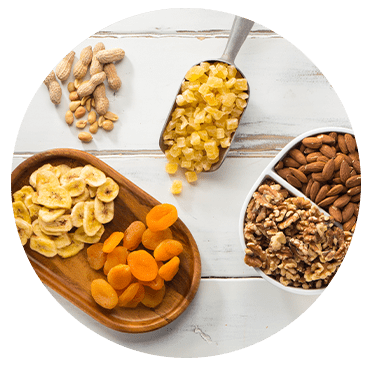With all of their bold heat, you might find it surprising that chile peppers are pretty versatile. Added whole to simmering soups and sauces, they can lend a flavor profile that will deliver delicious warmth to the palate. Their hollow bodies make the perfect vessel in which to stuff cheese for an ooey-gooey taste of Mexico. Chile relleno, anyone? Chiles are essential to salsas and add body to many savory dishes.
- Great stuffed, grilled, sautéed, on salad or right out of the bag
- Adds texture, bright color and sweet flavor to any dish
- Crunchy, juicy and delicious
- Naturally fat-free, loaded with vitamin C and a good source of fiber
Peppers are native to Asia and the Western Hemisphere and have been cultivated for thousands of years, but it wasn’t until Christopher Columbus brought the pepper back from his first voyage to America that Europe started enjoying this sometimes sweet, sometimes hot treat. Chile peppers are found in cuisines throughout the world. They are a popular ingredient in Asian, Latin and Caribbean cooking.
Hot Shots
Peppers generally fall into two flavor categories: sweet and hot. Heat levels of both mild and hot peppers are rated in Scoville units, a method developed by Wilbur Scoville in 1912. In the old days, human tasters were subjected to sampling the peppers to rate them. Today a process known as HPLC or high-performance liquid chromatography is used to measure the amount of capsaicin in parts per million. The capsaicin is what gives peppers their heat.
Bells
Bell peppers come in a rainbow of colors and account for more than 60 percent of the domestic pepper crop. Although all bell peppers are green when immature, most turn red, yellow, orange, purple or brown as they ripen. Colored bell peppers are usually sweeter than their immature green counterparts.
Add bell peppers to raw salads, or cook them in soups, stews and stir-fries. They also add crisp texture and fresh flavor to salads and sandwiches. Bell peppers are also ideal for stuffing with grains like rice or quinoa, fresh herbs and ground meat. Baked and served with a green salad, you’ll have a satisfying supper in no time!
Scoville Rating: 0
Anaheims
The heat of these peppers can range from mild to hot depending on their growing conditions. Like bell peppers, young Anaheims are green and mature to a vibrant red. They can be eaten in either color, but the preferred hue for an Anaheim is green. Anaheims are the chilies most often used in Chili Relleno, meaning stuffed chili in Spanish. They are also often used for rustic Southwest décor, dried when they turn red and strung into wall hangings and wreaths known as ristas.
Scoville Rating: 500-2,000
Poblanos
Another chili often dried is the poblano, a long and pointed dark-green pepper with a mild to medium heat. Dried poblanos are called anchos, a dark-purplish pepper with a savory sweet flavor. Ancho chilies are often ground into powder and used to season many foods. Poblanos and anchos are often used to make the Latin masterpiece, molé.
Scoville Rating: 1,000-2,000
Jalapeños
Jalapeños are stubby, pointed peppers that come in red and green. They are the quintessential pepper for Tex-Mex foods. They are often pickled and used as a topper for sandwiches, nachos, quesadillas and more. Fresh, they are the most popular chili for use in salsas. Smoked jalapeños are known as chipotles and they add plenty of savory heat and flavor to stews, enchiladas and casseroles. Remove the veins and seeds from the jalapeños for milder flavor, or leave them in for extra heat. Next time you’re making soup from scratch, add a whole jalapeño to the stock pot. Remove the pepper, and shred the chicken when the stock is ready. Add the chicken, roasted corn kernels and toasted corn tortilla strips instead of noodles. Top with a dollop of sour cream, finely diced jalapeños, a sprinkle of cilantro and a little shredded Jack cheese.
Scoville Rating: 3,500-8,000
Serranos
Serranos are thin, long and green. They are popular in Mexican and Chinese cooking. Substitute serranos for jalapeños in any dish.
Scoville Rating: 8,000-23,000
Habañeros
Small and super-spicy, the fiery orange color of the habañeros is a telltale sign of the heat within. Most bottled hot sauces are made from habañeros. Give your next pot of pasta sauce a little pizazz! Using a fork, poke holes in one or two habañero peppers and toss them in the sauce while it simmers. Be sure to fish out the peppers before serving!
Scoville Rating: 200,00-350,000 (Wilbur!)
When choosing your peppers, from bells to serranos, look for firm, smooth, evenly colored skin. The stem should look fresh and green. Avoid peppers with wrinkled skin or soft spots.
Preparing Peppers
Peppers take on a wonderful smoky flavor when broiled, grilled or fire-roasted. Follow these easy steps for each method and you’ll have a uniquely flavored ingredient that will add rich smokiness to your soups, salads, sauces or casseroles!
Broiling or Grilling
- Slice the pepper lengthwise into four or five panels. Discard the stem, ribs (which can have a bitter taste) and seeds.
- Brush the pepper with a light layer of olive oil.
- If grilling, lay the pieces on the grill, skin-side down; or if broiling lay the pepper on the broiling pan, skin-side up and cook about four inches from the heat.
- Grill or broil the pepper until the skin is blackened.
- Place the peppers into a bowl or closed zipper-style plastic bag and let them “sweat” for about 15 minutes. This loosens the skin.
- Gently peel off the skin and discard. The pepper is now ready to be added to your favorite recipe!
Fire-Roasting
- Cut a small slit near the stem of the pepper.
- Impale each pepper on a long-handled cooking fork and hold over the flame of a gas stove or grill.
- Turn to char the skin evenly.
- Once charred, follow the same procedure for removing the skin as above.





















 VIEW ALL
VIEW ALL



